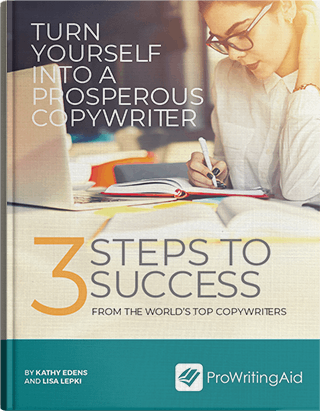
Have you ever read a first draft of your article or book and felt like it's just not good enough?
I'd like you to reframe your thinking. Even when you're writing non-fiction, the job of a first draft is to exist. It doesn’t matter if the writing is flabby or your ideas half-baked.
Many writers call their first pass the "vomit draft." So expect misplaced apostrophes. Become friends with the passive voice (at least for now). And forgive those clunky sentences. It takes several revisions to shape up a first draft so it's good enough to publish.
We’re going to get there during the editing process using these 11 self-editing tips.
- 1. Use the Active Voice
- 2. Eliminate Unnecessary Words
- 3. Cut 10% of Your Work
- 4. Simplify Clunky Language
- 5. Format for Your Readers
- 6. Review Your Punctuation Choices
- 7. Replace Repeated Words
- 8. Write Compelling Sub-Headings
- 9. Include Transition Words
- 10. Get Lazy Writing into Shape
- 11. Self-Edit More Than Once
- It's Time to Act
1. Use the Active Voice
The active voice is engaging to read, whereas the passive voice adds distance between you and your reader.
The passive voice demonstrates how the subject of a sentence changes because of an action. For example, consider:
"This chapter was rewritten until it was good enough to publish."
Several sentences like that will turn off any reader.
Let's try:
"I rewrote this article until it was good enough to publish."
That’s better.
2. Eliminate Unnecessary Words
Say goodbye to needless metaphors, adjectives and adverbs. For example, instead of:
"I wrote my non-fiction article as fast as the wind."
Try:
"I wrote my first draft in thirty minutes."
You should also avoid clichés like the plague (there's one). Remember, brevity is clarity, which brings us to...
3. Cut 10% of Your Work

When Stephen King was a fresh-faced writer, he taped a piece of editorial advice to his desk. It read:
"Formula: 2nd Draft = 1st Draft — 10%. Good luck."
If you’re struggling to reduce your word count, ask yourself "Is this sentence confusing?" or "What’s the weakest section in this draft?" Remove or clarify what you can. Remember, if you felt bored or confused while reading your article, your readers will too.
4. Simplify Clunky Language
New writers sometimes include big words and long sentences to impress their readers. This type of writing puts people off.
Instead, rewrite sentences until a sixth-grader can understand them. This means writing short sentences and removing clunky words. It's key if you want to reduce the bounce rate on your website or blog.
You can evaluate your writing using the Flesch score. In my ProWritingAid review, I explain how I use this score to simplify my non-fiction writing.
5. Format for Your Readers
Have you used compelling sub-headings that add value to your book? Have you formatted your writing using bold, italics, and so on?
List posts like this article are another example. You can hold the attention of readers by breaking up your article. That said...
6. Review Your Punctuation Choices
Unless you’re tweeting like Donald Trump, cut those exclamation marks! And don't write in all caps or overuse italics. This applies to your articles, social media posts and even emails. It applies even if you're writing dialogue.
7. Replace Repeated Words

Avoid using the same word over and over and over. It bores your readers. Instead, use Scrivener or ProWritingAid to search your articles for repeated words. Then, replace them with an original choice using a dictionary or thesaurus.
8. Write Compelling Sub-Headings
The job of a sub-head is to invite scanners to read your article before they move on…and then to hold their attention from the first word to the last. Think of them as mini-headlines.
While editing your article, turn each sub-head into something specific, emotional, or unusual. ("Conclusion" is a common example of a bland sub-heading.) When in doubt, start your sub-heading with a verb. If you're drawing a blank, write your sub-heads after you've finished the body of your article.
9. Include Transition Words
These words bridge one sentence to the next and connect different ideas. They’re kind of like small talk before a difficult conversation. You can pick from hundreds, including:
- Moreover
- Initially
- Here's the thing
- What’s more
- So…
- And yet
They're not essential, but they'll help your writing flow.
10. Get Lazy Writing into Shape
I like to keep a list of my lazy writing mistakes. This list includes words and ideas I overuse or rely on when I can't think of anything else.
The word "make" is one example from my list. Writers rely on this general verb when they can't think of a more specific one. For example:
"Do you make a living from your books?"
Or...
"Do you earn a living from your books?"
Some non-fiction writers also overuse words like:
- However
- In summary
- Many
- Great
- Like
- Actually
- Be or being
- Consider or considered
11. Self-Edit More Than Once
Many new writers ask, how many rounds of editing is enough? Typically, I edit an article between one and three times. First, I edit the overall structure of the article. Then, I edit the individual parts of the article. Finally, I polish the piece in question.
Depending on your work, you might need to edit it once. Or you might have to edit it several times. Remember: fix the big problems first, then zoom in on the small problems. That said, please don’t allow your pursuit of perfectionism to stop you from pressing publish.
Anne Lammot offers this advice:
"Perfectionism is the voice of the oppressor, the enemy of the people. It will keep you cramped and insane your whole life, and it is the main obstacle between you and a sh*tty first draft."
It's Time to Act
At the end of your article? Don't just end it abruptly. Instead, summarize what you said in your article, give your readers a takeaway, or call them to act.
Learning how to self-edit, much like getting fit, isn't easy. But, it's worthwhile. With a little hard work and patience, you can publish something you're proud of. Still need help help? I want to give you 101 free writing prompts you can use today.


